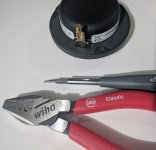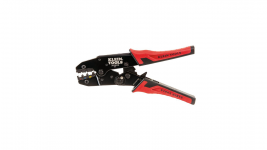No NASA fans? Does anyone use gold on gold? There might be a hook in my mouth but I like the idea of it.
NASA crimp rejection rules:
Brittle Gold Plating on Contacts

If you are new to crimping, be sure to give a nice pull test. Also, it can help to use a small screwdriver to stretch a "female disconnect" to fit the driver. I had to buy every gold disconnect size on partsexpress to do a 3way.
NASA crimp rejection rules:
Brittle Gold Plating on Contacts
c. Crimped Connections (1) Metal ferrules crimped with improper alignment. (2) Cracks in crimp barrel. (3) Birdcaging of conductor. (4) Wire strands not visible in inspection hole. (5) Peeling or flaking of plating on contact. (6) Damaged or deformed crimp contact. (7) Crimp indents not located in the correct area on the contact. (8) Tarnished, corroded, or contaminated crimp contact. (9) Improper insulation clearance. (10) Insulation whiskers that extend into the crimp barrel.

If you are new to crimping, be sure to give a nice pull test. Also, it can help to use a small screwdriver to stretch a "female disconnect" to fit the driver. I had to buy every gold disconnect size on partsexpress to do a 3way.
I’ve seen (too) many a speaker with crimps on the drivers ,….. that need attention.
I.e. the crimp to the cable is perfectly fine and gas tight, but the crimp on the spade is loose - it becomes quite obvious when you disconnect. (Sometimes not only loose but one ‘roll’ has fractured completely !!
I have in the past either had to squeeze up the roll on the crimp to better grab the spade , or replace the crimp , or simply chop off and solder !
I’m not sure if it’s because it’s been repeatedly disconnected/connected or they’ve used the wrong crimp/faston for the spade thickness (not width) in question
I.e. the crimp to the cable is perfectly fine and gas tight, but the crimp on the spade is loose - it becomes quite obvious when you disconnect. (Sometimes not only loose but one ‘roll’ has fractured completely !!
I have in the past either had to squeeze up the roll on the crimp to better grab the spade , or replace the crimp , or simply chop off and solder !
I’m not sure if it’s because it’s been repeatedly disconnected/connected or they’ve used the wrong crimp/faston for the spade thickness (not width) in question
Last edited:
No NASA fans? Does anyone use gold on gold?
Fan? I guess you could call my involvement with them as being a 'fan', but in [fractional] electrical low, medium, high voltage power controls distribution, gold wasn't used in my time that ended in '94 and considering how inefficient audio speakers are, don't see the need for it in a typical HIFI/HT app, but if quality gold plated connectors can be had at competitive prices, then sure, why not?
Gold-on-gold is quite common in low-voltage electronics and telecom. "Brittle gold plating" is quite interesting as a phenomenon, but one that I would hardly think is commonplace. Sticking with industry leaders (AMP, Molex, etc.) for connector parts should keep you in the clear.No NASA fans? Does anyone use gold on gold? There might be a hook in my mouth but I like the idea of it.
NASA crimp rejection rules:
Brittle Gold Plating on Contacts
View attachment 986715
If you are new to crimping, be sure to give a nice pull test. Also, it can help to use a small screwdriver to stretch a "female disconnect" to fit the driver. I had to buy every gold disconnect size on partsexpress to do a 3way.
My biggest takeaway from the NASA docs was that when soldering, a strong mechanical connection was of primary concern, then soldering could be done. I saw a post mention wiring working its way loose... I reckon with a strong mechanical connection, that the solder is less critical to the integrity of that connection than the initial mechanical one.
Also, isn't there something about lead free solder causing tin whiskers? Or am I confusing this with some Toyota stuff? I heard this is why some companies get an exemption for ISO, as the solder they use isn't lead free?? These last points could be word soup from my other butt... Take with grain of salt.
The spades/crimp connectors are welcome on any application I know I willl be swapping parts on. I hate dragging out soldering gear for single wires.
Also, isn't there something about lead free solder causing tin whiskers? Or am I confusing this with some Toyota stuff? I heard this is why some companies get an exemption for ISO, as the solder they use isn't lead free?? These last points could be word soup from my other butt... Take with grain of salt.
The spades/crimp connectors are welcome on any application I know I willl be swapping parts on. I hate dragging out soldering gear for single wires.
Right, in UL/CSA [destruction] testing, a cold weld [crimp] bested them all and in some cases soldering weakened them in short circuit testing.
Re the 'pull' test, all this testing is predicated on it in that any connection has to survive intact from an incredibly high current/voltage short relative to the desired rating. Nothing like a 1000 mcm cable whipping around the room spewing an electrical arc of incredible power to get your attention.
Dunno, 'tin whiskers' doesn't 'ring any bells' for me during my time involved with industrial electrical power and controls testing and in a search, don't believe it would be a problem: Attention Required! | Cloudflare
What is a problem is that some materials requires treatment before plating, which can mean poor performance if not done or done properly, so again, best to stick with industrial, etc., approved components: Silver Electroplating Company | Silver Plating Services Per QQ-S-365, ASTM B700 & AMS 2410 Specifications
Re the 'pull' test, all this testing is predicated on it in that any connection has to survive intact from an incredibly high current/voltage short relative to the desired rating. Nothing like a 1000 mcm cable whipping around the room spewing an electrical arc of incredible power to get your attention.
Dunno, 'tin whiskers' doesn't 'ring any bells' for me during my time involved with industrial electrical power and controls testing and in a search, don't believe it would be a problem: Attention Required! | Cloudflare
What is a problem is that some materials requires treatment before plating, which can mean poor performance if not done or done properly, so again, best to stick with industrial, etc., approved components: Silver Electroplating Company | Silver Plating Services Per QQ-S-365, ASTM B700 & AMS 2410 Specifications
Last edited:
Member
Joined 2009
Paid Member
If building myself, I always add solder to a crimp, and sleep soundly afterwards.
For a permanent set up I'd even consider solder everything including phono connections! (i.e. hard wired without connectors)
For a permanent set up I'd even consider solder everything including phono connections! (i.e. hard wired without connectors)
Last edited:
Soldering a crimp connector reduces its fatigue & vibration resistance, unless you do it in a way that does not affect the actual crimp.If building myself, I always add solder to a crimp, and sleep soundly afterwards.
For a permanent set up I'd even consider solder everything including phono connections! (i.e. hard wired without connectors)
For me, I like to solder the "loose end" (free end) of the wire, such that the solder is wetting both the end of the wire as well as the connector, but the portion of the wire in the crimp stays totally free of solder.
The limiting factor in a diy crimp is the resultant mechanical connection. Those done by industrial machinery typically don't need any help, except for maybe a sealing agent. With a hand held crimper, the best way ime is to use hot solder as a lubricant while bearing down on the crimper, holding it til the solder cools. Tricky but this way the crimp is tighter to start with and does not spring back when the tool is released. Hot solder is a remarkable lubricant.
A ratcheting crimper such as this is capable of making a crimp that meets SAE and MIL-STD requirements for high vibration environments. The terminal size must be matched to the wire size, and the crimper must be matched to the terminal size and type. The wire must be stripped to the correct length. The crimper tool must be squeezed until it ratchets fully close and then releases.
If solder is used in the connection, it will no longer meet SAE or Mil-STD requirements.
The tool I pictured is designed to be used with terminals that have a nylon insulation sleeve over the ferrule. Non-insulated terminals require a different crimping tool.
Avoid the cheap $5 crimpers or combo tools which simply dent the terminal ferrule in an uncontrolled way.
j.
If solder is used in the connection, it will no longer meet SAE or Mil-STD requirements.
The tool I pictured is designed to be used with terminals that have a nylon insulation sleeve over the ferrule. Non-insulated terminals require a different crimping tool.
Avoid the cheap $5 crimpers or combo tools which simply dent the terminal ferrule in an uncontrolled way.
j.
Attachments
In a damp environment, the bare wires should be dipped or sprayed with a corrosion-inhibiting dielectric spray or grease before they are inserted into the ferrule. Heat shrink tubing or other coating is usually applied. This is what I do in a marine environment installation or in the engine compartment of a vehicle. However, inside a speaker cabinet, I don't bother with heat shrink.
j.
j.
- Home
- Loudspeakers
- Multi-Way
- Spades or solder for drivers.
